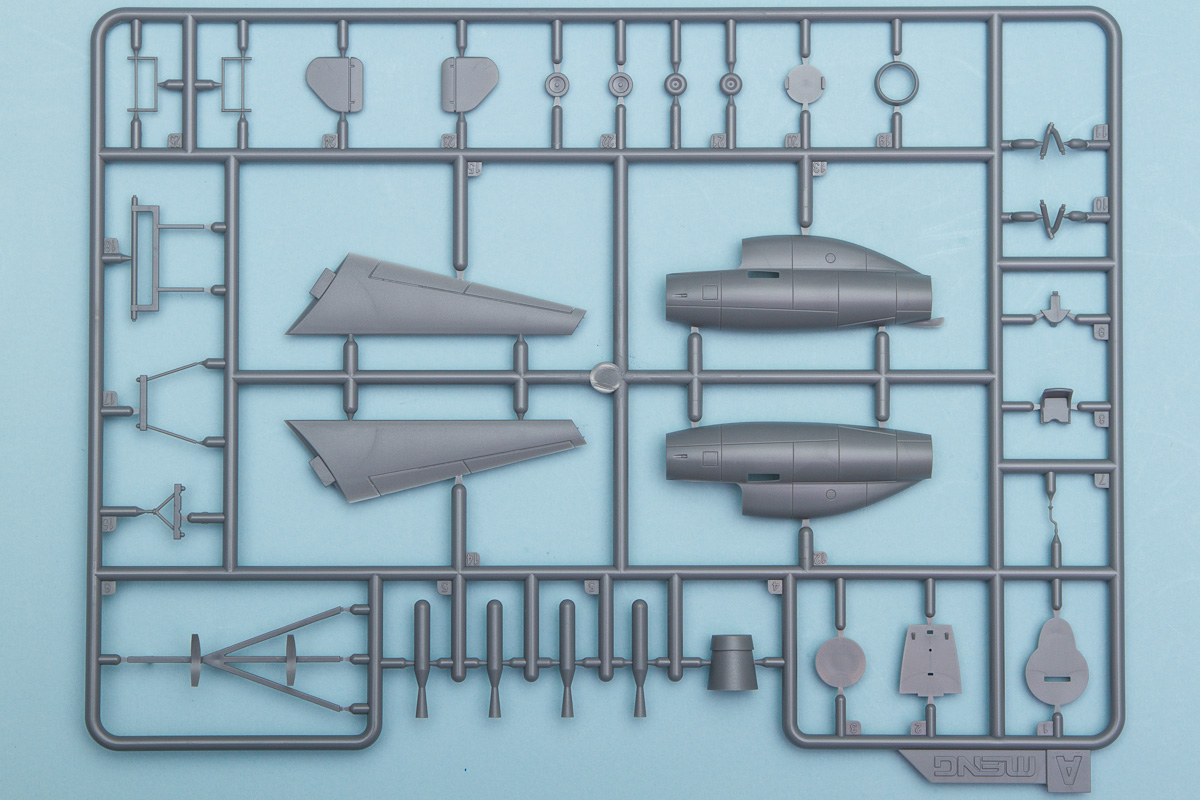
Meng 1/72 Kayaba Katsuodori Ram-Jet Fighter
By Chris Banyai-Riepl
Overview
The push for greater performance resulted in quite a few interesting concepts from all over the world, and the outbreak of war in the late 1930s had Japan looking at alternate power sources. The Kayaba Ramjet Study Group began design of a ramjet-powered aircraft in 1937. With assistance from technology transfer from Germany, research progressed quickly, and although there is no date on the information recovered, it is assumed that design of the Katsuodori took place in the middle of the war.
Similar in design to the Heinkel He P.1078C, the Katsuodori featured a tailless fuselage with a sharply swept wing. The plan was to use four solid fuel rocket boosters to propel the aircraft to speed, and then switch on the ramjet propulsion system. Taking off on a wheeled support dolly, much like the Messerschmitt Me 163, the Katsuodori would jettison the dolly, fly its mission, and return to earth by landing on a reinforced skid. The arrival of the Me 163 design, though, effectively killed further research on the Katsuodori, as the Me 163 was a proven design, flying in Germany.
The Kit
Meng is a new company in the model kit world, and their most recent kits have focused on 1/35 scale vehicles. Their first foray into aircraft subjects is the interesting Japanese subject, the Kayaba Katsuodori ram-jet interceptor. Molded in gray plastic, the kit actually comes with two complete models in the box. The model features recessed panel lines throughout, a reasonably detailed cockpit and two interesting marking options.
 The first step deals with the cockpit. This is a simple arrangement, with a one piece floor, a rear bulkhead, the seat, instrument panel and control stick. While most of the detailing this very basic and plain, the control stick is very petite to end the instrument panel does have some raised details. The other internal details concern the ram jet, with a separate nose inlet and rear exhaust cone. Both of these get an insert providing the engine face. With the cockpit and engine assembly is done, the fuselage can be closed up. Split into right and left halves, this should go together easily, with minimal seams. The one piece canopy is very clear and thin.
The first step deals with the cockpit. This is a simple arrangement, with a one piece floor, a rear bulkhead, the seat, instrument panel and control stick. While most of the detailing this very basic and plain, the control stick is very petite to end the instrument panel does have some raised details. The other internal details concern the ram jet, with a separate nose inlet and rear exhaust cone. Both of these get an insert providing the engine face. With the cockpit and engine assembly is done, the fuselage can be closed up. Split into right and left halves, this should go together easily, with minimal seams. The one piece canopy is very clear and thin.
With the fuselage together, the next step is assembling the wings. This is very simple, as the wings are molded as one piece. The vertical fins at the wingtip are separate, and fit onto two small pegs. With the wings on, the assembly is pretty much done at this point. The next step is to figure out how you want displayed a finished model. The kit comes with four different options for displaying the finished aircraft. The first option has attached rocket boosters to the fuselage. The rocket boosters are cast individually and feature hollow exhausts. There are two for each side, and there is a separate mounting bracket.
 For those who like wheeled options, there are two choices in this kit. The first option is a carrying dolly. This is made up from two pieces for the main frame, with two separate wheels. The other wheeled option is basic landing gear. These are represented with petite U-shaped struts and separate wheels. The final option is for those who wish to mount it to the carrier aircraft. For this option there are two large mounting struts. The carrier aircraft options include the Nakajima Ki-49 Helen and Nakajima Ki-67 Peggy in the IJAAF, and the Nakajima G5N, Mitsubishi G7M, Nakajima G8N, and Nakajima G10N for the IJN.
For those who like wheeled options, there are two choices in this kit. The first option is a carrying dolly. This is made up from two pieces for the main frame, with two separate wheels. The other wheeled option is basic landing gear. These are represented with petite U-shaped struts and separate wheels. The final option is for those who wish to mount it to the carrier aircraft. For this option there are two large mounting struts. The carrier aircraft options include the Nakajima Ki-49 Helen and Nakajima Ki-67 Peggy in the IJAAF, and the Nakajima G5N, Mitsubishi G7M, Nakajima G8N, and Nakajima G10N for the IJN.
The decal options are both fictitious, as the aircraft never made it past the mockup stage, but they provide both an IJAAF and an IJN option. The IJAAF option is finished in overall light grayish green with the upper surface painted in dark green spots. The tail has an emblem on it, and there are kill markings for the nose, if so desired. The IJN example is overall IJN gray with red vertical fins. There is some Japanese writing on the tail fins, and similar kill markings on the nose for this option. The decals look quite good and should pose no problem.
Conclusion
This is an interesting subject for a first aviation kit, and it offers some interesting potential for those into paper projects and designs that never flew. My thanks to Stevens International for the review copy.
